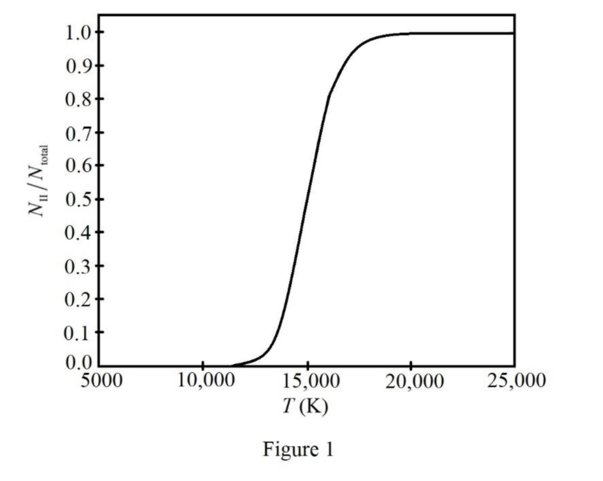
Concept explainers
(a)
To compare the ratios
(a)
Answer to Problem 8.10P
For all the given temperatures,
Explanation of Solution
In the case under consideration, the subscript I stands for neutral helium, II stands for singly ionized helium, and III sands for the completely ionized helium atom.
Given that the ionization energies
Write the expression for the Saha equation in terms of the electron pressure.
Here,
Rewrite equation (I) for determining the required ratios.
Conclusion:
Substitute
Similarly the values of the ratios
From the table it is clear that the ratio
Therefore, for all the given temperatures,
(b)
To show that
(b)
Answer to Problem 8.10P
The ratio
Explanation of Solution
Given ratio expression is;
Take
Multiply and divide the third term in the denominator in equation (V) with
Equation (VI) is the form of the equation (IV) written in terms of the ratios
Conclusion:
Therefore, the ratio
(c)
To plot the graph of
(c)
Answer to Problem 8.10P
The plot the graph of
Explanation of Solution
The expression for
From the obtained values of
With the given values of electron pressure, ionization energies and partition functions for the neutral helium atom and singly ionized helium atom, the ratio
Conclusion:
The graph of

From the graph it can be noted that when the temperature corresponding to the partial ionization of the neutral helium is about
Want to see more full solutions like this?
Chapter 8 Solutions
EBK AN INTRODUCTION TO MODERN ASTROPHYS
- explain in simple terms how does particle swarm optimsation work.arrow_forwardMy question is that I don’t understand what happened in the second page from where it says we obtain: I get how we got X but I don’t get how we get alpha in the first page and then use it in the second page till we get the final formula if you can please show me the steps of finding the final formulaarrow_forwardFor a search volume that requires: 45 beam positions, 333 range bins, 32 Doppler bins, and a P FA of 5 × 10 − 3 , how many false alarms occur on average in a single search frame?arrow_forward
- Derive the group velocity for the Rossby wave and compute the phase velocity for the envelope at latitude 30 degrees, if the wavelength is 350km and the current is moving from west to east with a speed of 10m/sarrow_forwardGiven that the line charge density is \lambda = { {dq} \over {dx} }, what is the proper LaTeX formulation of the charge in terms of the line charge density and length?arrow_forwardCalculate the total number density ( ntot ) and the density ( ρ ) at a depth in a star composed of pure hydrogen where T = 9500 K and 35 % of the atoms are ionized (assume UI = 2). What percentage of hydrogen atoms are in the energy level n = 2?arrow_forward
- what is the answer for sub-item (b) if the radius of the neutron star is 6.676 km? (express your answer in the proper SI unit and without scientific notation) (b)What is the average density of a neuron star that has the same mass as the sun but a radius of only 20.0 km?arrow_forwardWhy the Townsend’s first ionization coefficient α is impacted by gas pressure? Explain.arrow_forwardAssume a hydrogen atom is a sphere with diameter 0.100 nm and a hydrogen molecule consists of two such spheres in contact. (a) What fraction of the space in a tank of hydrogen gas at 0°C and 1.00 atm is occupied by the hydrogen molecules themselves? (b) What fraction of the space within one hydrogen atom is occupied by its nucleus, of radius 1.20 fm?arrow_forward
- Calculate the photon capture radius and the Schwarzchild radius of M87* (in AU).arrow_forwardLet the mass of the sun be denoted by Ms and its radiative power P. Determine the smallest possible spherical dust particle of density D that can stay in the solar system. Hint: compare the attractive gravitational force with the repulsive radiative forcearrow_forwardBased on the problem attached, what is the answer for sub-item (b) if the radius of the neutron star is 67.004 km? (express your answer in the proper SI unit and without scientific notation)arrow_forward
 Modern PhysicsPhysicsISBN:9781111794378Author:Raymond A. Serway, Clement J. Moses, Curt A. MoyerPublisher:Cengage Learning
Modern PhysicsPhysicsISBN:9781111794378Author:Raymond A. Serway, Clement J. Moses, Curt A. MoyerPublisher:Cengage Learning
